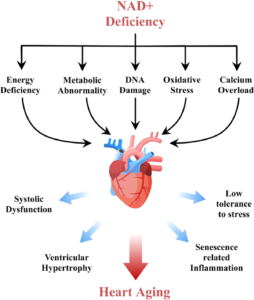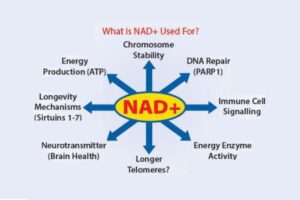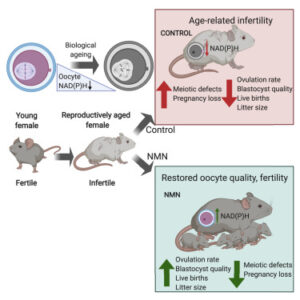NAD+ Deficiency Linked to Birth Defects and Miscarriages
Written By: Kavya Reddy
Of the 4-8 million babies born globally each year, around 3-5 percent are born with severe birth defects (Victor Chang, 2024). Furthermore, 10-20 percent of all pregnancies are at risk of ending in a miscarriage (Victor Chang, 2024). There are many underlying causes for birth defects and miscarriages during pregnancy but scientists at Sydney’s Victor Chang Cardiac Research Institute in Australia may have found one possible reason- NAD+ Deficiency during pregnancy.
What is NAD+?
Nicotinamide adenine dinucleotide (NAD+) is an enzyme that is used in redox reactions. Redox reactions are a type of chemical reaction that occurs between an oxidizing substance and a reducing substance. The oxidizing substance loses electrons while the reducing substance gains electrons. NAD+ reacts with a hydride and is reduced to the metabolite NADH. NAD+/NADH are essential for cellular metabolic reactions. As a result, this molecule is crucial for energy metabolism and has many cellular functions including DNA repair, chromatin remodeling, and immune cell function (Figure 1).
Figure 1

Model of how NAD+ deficiency impacts the heart organ
Source: Targeting NAD+: is it a common strategy to delay heart aging? (Yuan et. al, 2022)
Using animal models, scientists have discovered that a decline in NAD+ levels is associated with cognitive decline, cancer, metabolic disease, sarcopenia, and frailty (Covarrubius et. al, 2020). By increasing NAD+ levels, there might be a possibility to reverse the progression of these diseases.
How Does NAD+ Impact Pregnancy?
To figure out how NAD+ functions during pregnancy, researchers utilized mice with dysfunctional endothelial γ-aminobutyric acid type A (GABAA) receptors. This dysfunction results in the development of many stress disorders. The researchers administered NAD+ and noticed that this treatment restored blood vessel formation. These findings indicate that NAD+ is important for brain formation and blood flow in the brain (Subbaraju, et. al. 2020).
Another study done on mice confirmed these conclusions from the aforementioned study. Their results showed that NAD+ deficiency during the early stages of embryo formation was the biggest reason for early fetal demise. Even mice mothers with no prior genetic condition had miscarriages and/or gave birth to offspring with birth defects. They concluded that sufficient NAD+ supply is crucial for the proper development of the fetus and a safe pregnancy for the mother (Cuny, et. al. 2020).
Figure 2

Diagram of the Different Functions of NAD+
Source: NAD The Secret Of Life And Anti-Aging (Dr. Purita, n.d.)
Possible Solutions
A growing number of studies have proven that Vitamin B3 boosts NAD+ production. To understand the importance of Vitamin B3, scientists conducted an animal study on mice embryos. The female mice were fed a diet without Vitamin B3. Consequently, these females either had a miscarriage or produced offspring with severe birth defects. Once the mice’s diet was supplemented with Vitamin B3, no miscarriages occurred and all the offspring were born healthy (Victor Chang, 2017).
Figure 3

The Effect of Varied NAD(P)H (alternatively, NAD+/NADH) Levels in Mice Pregnancies
Source: NAD+ Repletion Rescues Female Fertility during Reproductive Aging (Bertoldo et. al, 2020)
The findings of this study are relevant to the human population. Researchers conducted a study of 563 women at the obstetrical clinic of the New Jersey Medical School. They noticed that a third of pregnant women had a B3 deficiency during their first trimester when organs start developing. By the last trimester, around 60% of women had depleted B3 levels (Baker et. al, 2002). Scientists noticed that even though pregnant women were taking vitamin supplements, their B3 levels were still low (Victor Chang, 2017).
Future Implications and Goals
Over time, doctors and scientists are noticing a rising trend in birth defects and miscarriages. By identifying the reason behind this occurrence, doctors can implement interventions to save the lives of many babies.
More research is needed to study the impacts of increased Vitamin B3 supplementation in pregnant women. As of right now, scientists do not know the specific B3 dose requirement during pregnancy. Studies have only been done on animal models, not humans. Furthermore, excessive consumption of Vitamin B3 may lead to detrimental effects on the mother and baby (NSW Health, 2017). As a result, NSW Health currently suggests women should not change their diet or add any extra supplements.
Scientists must also gain a better understanding of the physiological role of NAD+, specifically in humans, the impacts of elevated and depleted levels of NAD+ on human fetus development.
Conclusion
Current research points to NAD+ deficiency being the main cause of miscarriages and birth defects. However, these findings are still limited as more research has yet to be conducted on humans. If these findings are corroborated, scientists can then design treatments to prevent and mitigate complications in pregnancy.
References and Sources
2024 Update on Pregnancy Breakthrough – Victor Chang Cardiac Research Institute. (n.d.). The Victor Chang Cardiac Research Institute. Retrieved April 16, 2024, from https://www.victorchang.edu.au/news/new-nad-study
Baker H, DeAngelis B, Holland B, Gittens-Williams L, Barrett T Jr. Vitamin profile of 563 gravidas during trimesters of pregnancy. J Am Coll Nutr. 2002 Feb;21(1):33-7. doi: 10.1080/07315724.2002.10719191. PMID: 11838885.
Bertoldo, M. J., Listijono, D. R., Ho, W.-H. J., Riepsamen, A. H., Goss, D. M., Richani, D., Jin, X. L., Mahbub, S., Campbell, J. M., Habibalahi, A., Loh, W.-G. N., Youngson, N. A., Maniam, J., Wong, A. S. A., Selesniemi, K., Bustamante, S., Li, C., Zhao, Y., Marinova, M. B., & Kim, L.-J. (2020). NAD+ Repletion Rescues Female Fertility during Reproductive Aging. Cell Reports, 30(6), 1670-1681.e7. https://doi.org/10.1016/j.celrep.2020.01.058
Covarrubias AJ, Perrone R, Grozio A, Verdin E. NAD+ metabolism and its roles in cellular processes during ageing. Nat Rev Mol Cell Biol. 2021 Feb;22(2):119-141. doi: 10.1038/s41580-020-00313-x. Epub 2020 Dec 22. PMID: 33353981; PMCID: PMC7963035.
Cuny, H., Rapadas, M., Gereis, J., Martin, E. M. M. A., Kirk, R. B., Shi, H., & Dunwoodie, S. L. (2020). NAD deficiency due to environmental factors or gene-environment interactions causes congenital malformations and miscarriage in mice. Proceedings of the National Academy of Sciences, 117(7), 3738–3747. https://doi.org/10.1073/pnas.1916588117
Dr. Purita. (n.d.). NAD The Secret of Life and Anti-Aging – Pensum Regenerative Medicine. Www.pensummed.pro. https://www.pensummed.pro/blogs/nad-the-secret-of-life-and-anti-aging
Pregnancy Breakthrough Statement – Victor Chang Cardiac Research Institute. (n.d.). The Victor Chang Cardiac Research Institute. Retrieved April 9, 2024, from https://www.victorchang.edu.au/news/pregnancy-breakthrough-statement
Pregnancy Double Discovery – Victor Chang Cardiac Research Institute. (2017). The Victor Chang Cardiac Research Institute. https://www.victorchang.edu.au/news/pregnancy-breakthrough
Sivan Subburaju, Kaye, S., Yong Kee Choi, Jugajyoti Baruah, Datta, D., Ren, J., Ashwin Srinivasan Kumar, Szabo, G., Dai Fukumura, Jain, R. K., Abdallah Elkhal, & Vasudevan, A. (2020). NAD + -mediated rescue of prenatal forebrain angiogenesis restores postnatal behavior. Science Advances, 6(41). https://doi.org/10.1126/sciadv.abb9766
Vitamin B3 supplementation in pregnancy – Maternal and newborn. (n.d.). Www.health.nsw.gov.au. https://www.health.nsw.gov.au/kidsfamilies/MCFhealth/maternity/Pages/vitamin-B3-in-pregnancy.aspx
Yuan, Y., Liang, B., Liu, XL. et al. Targeting NAD+: is it a common strategy to delay heart aging?. Cell Death Discov. 8, 230 (2022) https://doi.org/10.1038/s41420-022-01031-3